Side Menu:
Captain E.J. Smith - Response to Disaster
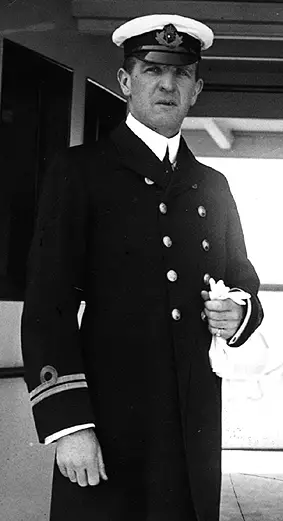
'Officer of the Watch' First Officer Murdoch on
the bridge of the R.M.S Olympic 1911.
(Click to enlarge)
Half an hour later, at 10pm, Second Officer Lightoller is replaced by First Officer Murdoch as Officer of the Watch. At 11:40pm lookout Frederick Fleet sees an iceberg dead ahead about 500 yards away towering some 55 – 60 feet above the water, and Murdoch subsequently orders "hard-a-starboard" and later "hard-a-port" in an effort to manoeuvre around it. At the time, Captain Smith is in his cabin. He likely hears a disturbance and immediately rushes out to the bridge, no doubt using the Chart Room door that connects his cabin with the bridge.
Was Captain Smith asleep?
While we cannot be sure exactly what Captain Smith was doing in his quarters at the moment of the iceberg collision, according to G.J. Cooper, in his book Titanic Captain: The Life of Edward John Smith, he is sure he was not asleep:
At both the American and British inquiries into the Titanic disaster Fourth Officer Boxhall testified quite specifically that he saw the captain on numerous occasions that evening from when he first arrived on the bridge during Lightoller's watch, up until the time of the accident... Boxhall remembered talking with Smith at his chart room door and clearly recalled that at 10pm Captain Smith, as was his want, personally marked down their 7.30pm star position….If Smith had stood talking with Boxhall so freely and so often, then it makes sense to suppose that he also had a few conversations with First Officer Murdoch just as he had earlier with Lightoller… So Smith was not asleep in his cabin, he was in fact at work, either plotting their progress thus far, puzzling a route around the reported ice, planning out the next day's navigation, or perhaps even taking time to complete the mass of official documents and requisitions he would have to present on reaching New York." (60.)
Second Officer Lightoller confirms this opinion, when he stated during the British Board of Trade Inquiry in answer to the question "Was the Captain dressed?" he responded: "That I could not say. I do not think there was any doubt about his being dressed, because in the ordinary conditions, as the Captain said, he would be just inside, he would not turn in under those conditions. He would just remain in his navigating room where his navigating instruments are: chart books, etc., where he would be handy to pop out on the bridge."(24.)
Smith's Response to the Collision
Immediately after the collision, Captain Smith rushes into the bridge and talks to the Officer of the Watch, First officer Murdoch.
Fourth Officer Boxhall, on Day 13 of the British Wreck Commissioner's Inquiry, described the conversation:
"He asked him what we had struck. The first Officer said, "An iceberg, Sir. I hard-a-starboarded and reversed the engines, and I was going to hard-a-port round it but she was too close. I could not do any more. I have closed the watertight doors." The Commander asked him if he had rung the warning bell, and he said "Yes.""
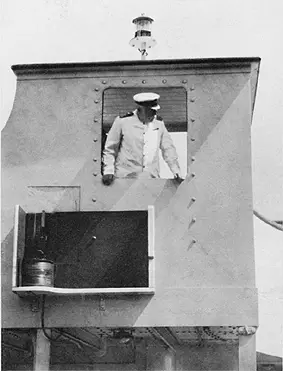
Captain Smith leaning out of the starboard
wing cab of the Olympic, as he would later
moments after Titanic's brush with an iceberg.
(Click image to enlarge)
After that, according to Boxhall, the Captain and the First Officer go to the starboard side of the bridge to see if they could see the iceberg, with Murdoch pointing it out.
The following is a guide as to Captain Smith's subsequent actions. Times are approximate:
1141pm Captain Smith changes the engine room telegraph to "Half-Ahead." Titanic's wireless Marconi room where
1142pm Smith orders Quartermaster Olliver to go and find the ship's carpenter and have him sound for damage.
1143pm Boxhall returns from taking a trip forward (on his own initiative) and reports he cannot see any signs of damage. However Smith does not trust this initial report and asks Boxhall to find the ship's carpenter to sound the ship.
1144pm The carpenter arrives on the bridge and reports that the ship is making water.
1145pm Postal clerk Jago Smith reports to the Captain that the mail hold, one deck below the post office on G deck, was filling with water.
1146pm Smith sends Quartermaster Olliver with a note to Chief Engineer Bell, probably asking for a damage report.
1147pm Smith changed the engine room telegraph to "Stop."
1148pm Chief Officer Wilde reports crewmen reporting air whistling out of the forepeak tank in the prow.
1149pm J.Bruce Ismay arrives on the bridge asking why they have stopped and Captain tells him they have struck ice and that it is serious.
1150pm Chief Engineer Bell reports to Smith Titanic is badly damaged but pumps should keep the ship afloat.
1151pm Boxhall returns to the bridge reporting the sea is only 2ft from the top of post office stairwell and heavy mail bags floating.
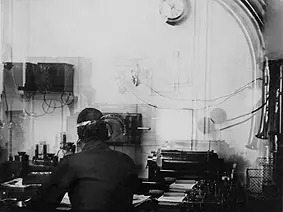
Captain Smith orders the operators Phillips
and Bride to 'send out a call for assistance'
(Click image to enlarge)
1152pm Smith visits the Marconi room and tells the wireless operators to 'get ready to send out a call for assistance. But don't send it until I tell you.' Fourth officer Boxhall is ordered by Captain
1153pm - 1204am Smith and Thomas Andrews inspect the ship.
1205am - Smith orders the officers to uncover the lifeboats, swing them out and get passengers wearing lifebelts. Chief Officer Wilde is ordered to muster the deck crew and uncover the boats, First officer Murdoch to rouse the passengers and Sixth officer Moody to to find the list for the lifeboat stations.
1206am Chief Engineer Bell confirms with the Captain that his men will keep the power supply running to the pumps and lights for as long as possible.
1210am Smith orders Quartermaster Walter Wynn to ready the two emergency boats first, before helping uncover the rest.
1215am Smith vists the Marconi room and orders "Send the call for assistance…the regulation internationa call for help." He supplies their position 41°,44'N, 50°, 24'W.
1220am Captain Smith confirms to Fourth officer Boxhall, uncovering the boats, that 'Mr Andrews tells me that he gives her from an hour to an hour and a half' and orders Boxhall to calculate their current position (which he calculates at 41°,46'N, 50°, 14'W).
1222am Captain Smith confirms to Second officer Lightoller to "Yes, swing out" the lifeboats
1224am Third Officer Pitman asks Captain Smith about putting passengers in the lifeboats on the starboard side - Smith says "Go ahead. Carry on."
1225am Captain Smith orders the lifeboats to be loaded with passengers.
1230am Captain Smith is seen speaking seriously to first class passengers JJ Astor and George Widener and is heard announcing to all to put their lifejackets on.
1235am Captain Smith at lifeboat no.4, port side, orders lamp trimmer Samuel Hemming to put lights in all of the lifeboat.
1236am Captain Smith orders all women and children waiting to enter lifeboat no. 4 to go down to A deck and enter from there, an order which Second Officer Lightoller follows through on.
1240am Wireless operator Bride reports to Captain Smith in the wheelhouse that the Carpathia was turning around and heading their way. Smith goes to Marconi room and orders them to send SOS instead of the CQD distress call. Smith calculates the Carpathia's position as 58 miles away, which will take 4 hours. As this is happening, lifeboat no.7, supervised by First officer Murdoch, is lowered into the water.
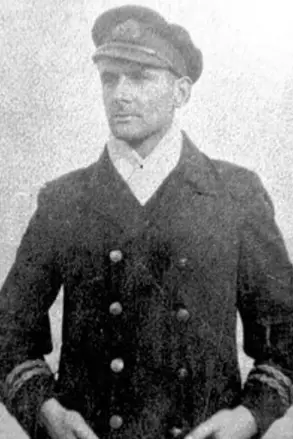
Smith to launch distress rockets, to try and
contact a steamer on the horizon and then
later to take command of lifeboat no.2
1245am Captain Smith is made aware by Fourth Officer Boxhall of a steamer on the horizon about 5 to 10 miles away and orders him to begin sending distress rockets every five or six minutes. He also order him to signal the mystery ship by Morse lamp to 'come at once, we are sinking.' inbetween firing the rockets. Captain Smith portrayed in The Graphic newspaper of
0105am Smith is seen by Seaman Frank Evans and dining steward William Burke during the lowering of lifeboat no.1 on the starboard side.
0106am Smith is seen by many crew and passengers including first class steward Alfred Crawford and Countess of Rothe's and her maid Roberta Maioni helping with loading of lifeboat no.8 on the port side.
0110am Captain Smith is seen by passengers helping with loading of no.6 on the portside and is seen using a megaphone to urge "Women and children first."
0115am Second Officer Lightoller leds Captain Smith along with Chief Officer Wilde and First officer Murdoch to the locker in Murdoch's cabin where the guns were kept and they were handed out along with ammunition.
0130am Captain Smith reports to the wireless operators that the engine room was flooding and operator Phillips broadcasts the message.
0140am Captain Smith orders Boxhall into Boat no.2 during loading.
0141am Captain Smith orders Quartmaster Rowe to continue firing rockets and to use the Morse code lamp to contact the 'mystery ship.
0145am Captain Smith shouts to Boxhall while lifeboat no.2 is being lowered to take his boat round to the starboard gangway hatch and load more passengers from there.
0200am Captain Smith tells Quartermaster Rowe to stop firing rockets and enter collapsible C.
0205am Captain Smith relieves Philips and Bride wireless operators with "You had better look out for ourselves."
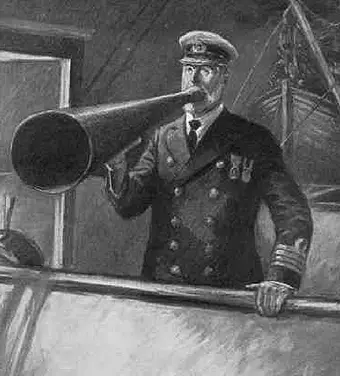
April 27, 1912, giving the "final order to the crew"
(Click image to enlarge)
0210am At collapsible B Trimmer Samuel Hemming sees Captain Smith calling out "Everyone over to the starboard side to keep the ship up as long as possible." and then later, several report seeing Captain Smith shotuting through a megaphone. "It's everyman for himself"
0215am Bridge goes under; Captain Smith is never seen again, presumed drowned.
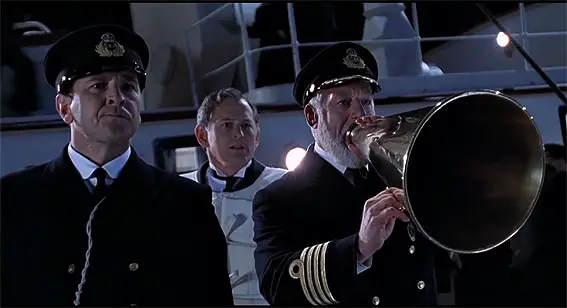
Captain Smith (Bernard Hill) portrayed
with a megaphone calling out to lifeboats to return.
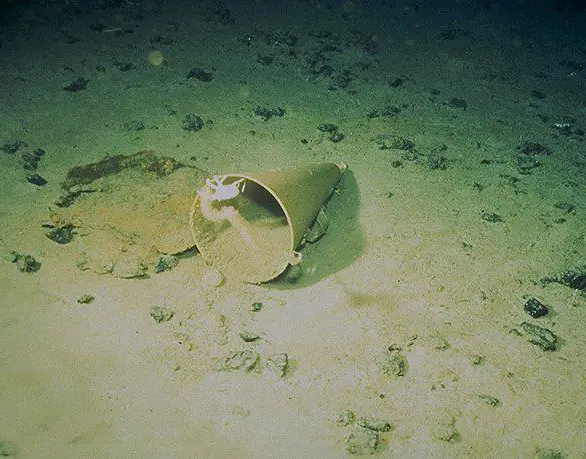
The megaphone as discovered on the seafloor.
For more information on the megaphone check this article here.
Many portrayals of Smith show him stunned and largely inactive after the collision but as the above list of events testifies Smith was indeed busy from the moment of collision until the end. Junior wireless operator Harold Bride testified to this at the British Inquiry, noting that Smith was "on the boat deck, the starboard side... He was superintending the loading of the lifeboats." Bride did not deliver all messages they were receiving in response to the distress calls because "Captain Smith was busy and we presumed he would be worried" but that "the Captain kept in communication with us; we either went to him or he came to us...He came in and told us at one time she would not last very long, and he informed us when the engine room was flooded." (British Inquiry)